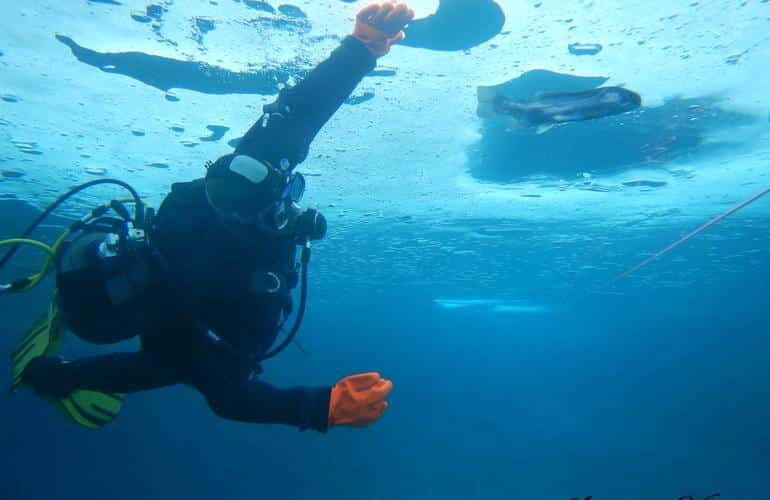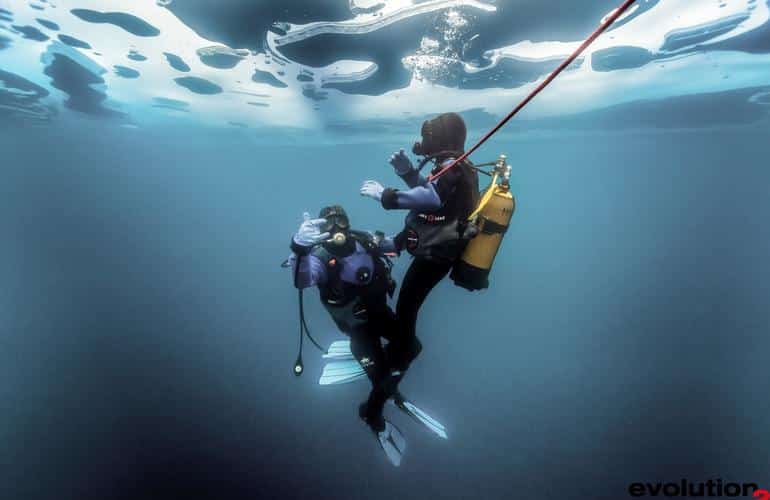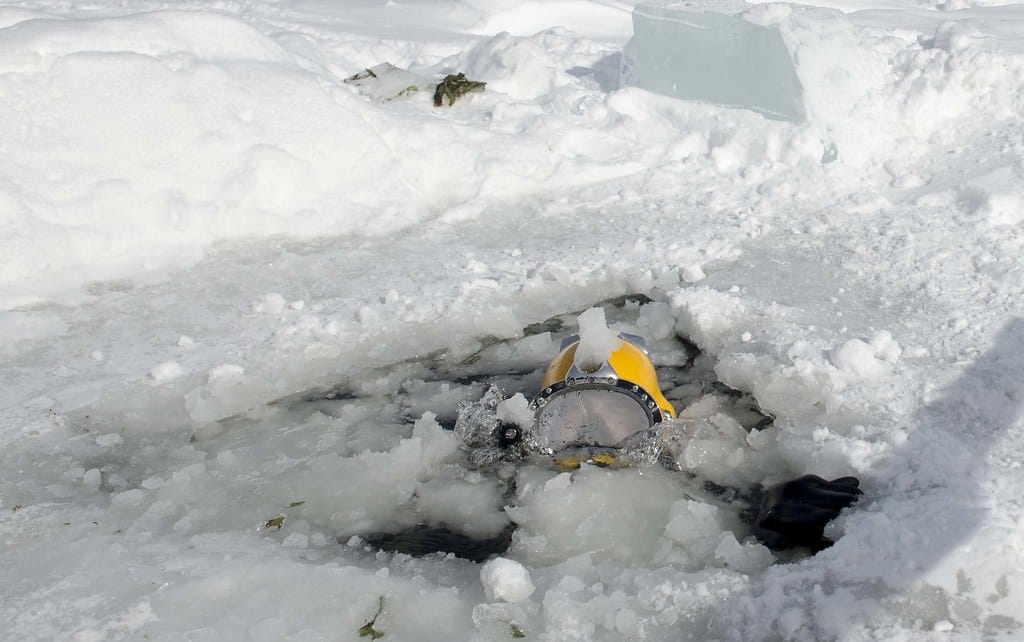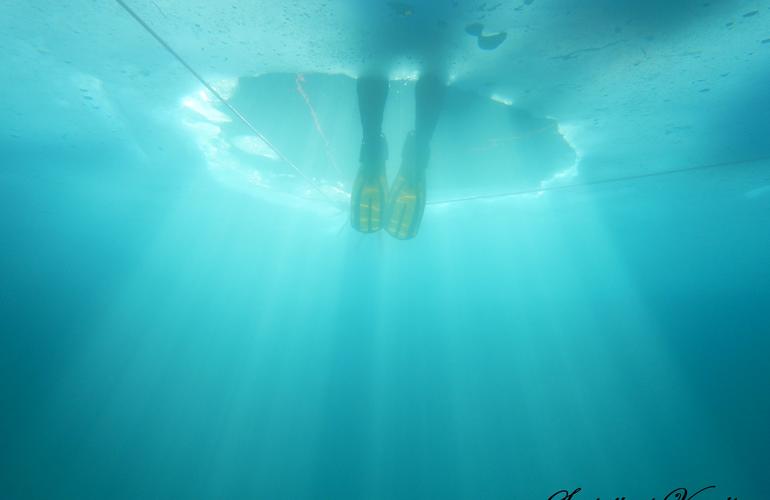All about Ice Diving

When the temperatures drop and the first snowflakes fall, many people immediately escape to distant paradises to enjoy the sun and swim in the warm sea. Here, however, we are going to tell you exactly the opposite: ice diving! Discover the crystal-clear waters of mountain lakes and be fascinated by the wonders of the ice and the play of light of the sun's rays through the ice. If you want to know everything about ice diving, you've come to the right place! This activity is probably the most original form of diving there is. And contrary to what you might think, you don't need to be cold-weather resistant or an experienced diver to practice. Ice diving is accessible to everyone, whether you are a beginner or an experienced diver. In all cases, professional supervision and appropriate equipment is required. Prepare yourself for an unforgettable experience, in complete safety and (almost) warmth.

What is ice diving?
Ice diving is a very unique form of diving where the diver, as the name of the sport suggests, dives under the ice in winter. The only point of entry and exit is a hole in the ice. This immersion in cold water requires not only special equipment but also careful preparation. Professional guidance by a qualified instructor is therefore essential.
And first of all, why go ice diving? Simply for the thrill of an unforgettable experience! And when we talk about thrills, we are not talking about the temperature, but mainly because it is a unique and unusual winter activity.
Who can go ice diving?
Ice diving is practised for several reasons: for scientific research: for example to study underwater life in the Arctic, for public safety, such as rescues, or for recreation. In this article we talk about the last one.
Ice diving for experienced divers
For experienced divers, ice diving is a must-do activity at least once in a lifetime. It is important to be well supervised by professionals as this type of diving differs greatly from normal scuba diving.
Specific training is required to teach divers how ice forms, how to recognise dangerous situations, the specific equipment needed, special safety drills and protocols, as well as dive entry and exit techniques. PADI organises specific "Ice Diver" courses. These courses are open to adult divers who already have PADI Level 2 (Advanced) certification.
Ice diving for beginners
But you don't need to have hundreds of dives in your logbook to enjoy ice diving. Beginners can also try ice diving and enjoy a unique winter experience during a special baptism!
The only conditions are that you must be in good health and over the minimum age (the minimum age depends on the provider, but it is often 16). Several providers in France offer introductory and discovery sessions, even if they are few in number. Ice diving centres are usually located in or near ski resorts, and diving is often done in mountain lakes rather than in open environments for reasons of convenience, accessibility and safety. On an ice diving trip, professional instructors are with you from start to finish, providing you with the necessary equipment and ensuring that your dive is safe. And it's not uncommon for your first ice dive to start a more general passion for diving! We will have warned you!
Specific risks of scuba diving
Ice diving presents risks that are different from those of "classic" diving. Beyond hypothermia (if you are not equipped with a dry suit), the main risks are disorientation/loss of bearings (not being able to find the hole to get out of the water) as well as a failure of the regulator which can freeze if it is not specifically designed for very cold water.
Fortunately, these risks are well identified. And the use of a dry suit, the compulsory installation of a lifeline (to find one's way back to the hole in the ice), and the use of a suitable regulator now allow you to dive in complete safety.
Nevertheless, this activity, especially for beginners, must absolutely be supervised by professionals. Not just anyone can become an ice diver!

Course of an ice diving experience
As you can see, ice diving cannot be improvised! But with professional guidance you can enjoy this extraordinary experience in complete safety. This is how a first ice diving session takes place.
The preparation
Often an ice diving experience takes place in a mountain lake during the winter months. You may witness the cutting of the ice before receiving a briefing on how the session will be conducted. Then you are fitted with a 100% waterproof suit (with boots, bonnet and gloves). These suits are so waterproof that you can wear conventional clothing underneath, such as fleece or other thermal layers.
Of course, you will also be provided with a tank and regulator set, as well as a mask, fins and gloves. The regulators are specially adapted for cold water diving, to avoid the risk of icing (the air cools down when it expands under pressure), with heat exchangers on the regulator. A surface assistant will be there to help you get properly equipped. Ice diving is a real team activity as for a dive in the water, several assistants must be present outside the water.
Immersion under the ice
Once you have been equipped and briefed you are ready to dive under the ice. The instructor will be at your side throughout the dive. Each diver is equipped with a lifeline that delimits the accessible area so that you don't get lost or trapped. A surface assistant makes sure that it stays taut throughout the session to prevent the diver from getting tangled in the lifeline, or stuck in the bottom of the lake. The only thing left to do is to let yourself be amazed by the spectacle of the ice, the light underwater and your air bubbles rising and getting stuck under the surface! With all this beauty you will quickly forget that the water around you is only 3 or 4 degrees. The time underwater is normally about 15 minutes for an ice diving experience.

Debriefing
At the end of your diving experience an assistant will help you to get out and un-equip. Warm up with a hot drink and share your experience with your instructor. And if your first dive made you want to do it again, why not try a night ice dive next time?
The best spots
Where there is ice, there is ice diving! But there are places on earth that are particularly beautiful to discover from the water, under a thick layer of ice. Even if these destinations are not always suitable for a first ice dive, we present below our favourites!
Antarctica
Covered in ice, snow and glaciers, Antarctica is predestined for ice diving. In a beautiful and wild setting, divers have the opportunity to see animals that are rarely found elsewhere, such as leopard seals, penguins and whales. Although Antarctica is beautiful, it is not the ideal spot for a first ice dive because the sites are not very accessible and diving there often requires the organisation of real expeditions.

Lake Baikal, Russia
A UNESCO World Heritage Site since 1996, Lake Baikal is located in southern Siberia. It is a lake of superlatives: the oldest, largest (freshwater), clearest and deepest in the world. An epic place for ice diving!
But diving here requires preparation and good equipment. The ice here can be up to two metres thick. However, the efforts are rewarded once you are underwater under this thick layer of ice. Indeed, a superb and unique underwater world awaits the divers. Perhaps they will come across one of the only three species of freshwater seals on earth, the Siberian seal...

Tobermory, Lake Huron, Canada
The crystal-clear waters and the lake's large size are not the only reason for the popularity of Lake Huron in Ontario, Canada. The presence of the small Fathom Five National Marine Park at the tip of the Tobermory Peninsula, which hides many treasures, has also helped the lake become famous. As well as ancient rock formations and green forests growing on the cliffs, the site is home to some 20 historic shipwrecks that are a diver's delight. In winter Lake Huron is covered in ice, making the discovery of the wrecks even more unusual and adventurous than in the summer.

Val Cenis, Haute Maurienne
No wrecks or seals, no 2-metre layer of ice, but an unusual experience guaranteed for beginners! We are talking about Val Cenis in the Vanoise National Park. Instead of an afternoon of skiing or snowshoeing, why not try your hand at ice diving? From December to April you can explore the watery world of a magnificent mountain lake. Accompanied by an instructor and several assistants, you can spend fifteen minutes discovering the life hidden under the ice. And if you can't give up the afternoon skiing, we have the solution for you: Go ice diving at night!

Now you know everything you need to know before you dive into the cold water. Check out our ice diving spots for beginners and get ready for your unusual adventure. For a little more inspiration check out our article on the most incredible ice dives.